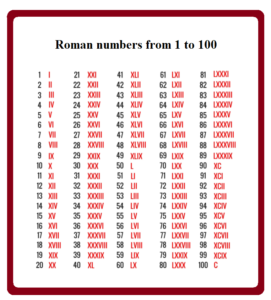Roman Numbers
Contents
What are Roman numbers?
The numerals 0, 1, 2, 3,…..,9 are used in writing are called Hindu -Arabic numerals. So far, we’ve used the Hindu-Arabic numeral system. This isn’t the only system available. The Roman numeral system is one of the first ways of writing numerals used by the Romans in the past. In many places, this system is still in use. For example, Roman numerals are used in clocks; they are also used for classes in school time tables, used in numbering of different volumes of books , and so on. Alphabets are used to write fixed positive integers in roman numbers.
There are seven basic symbols( I, V, X, L, C, D and M) to write any Roman numbers. These symbols with their corresponding Hindu-Arabic numbers are given below:
| Roman numeral | I | V | X | L | C | D | M |
| Hindu Arabic Numerals | 1 | 5 | 10 | 50 | 100 | 500 | 1000 |
In the roman number system , there is no symbol for 0. This system is also not a place value system. Using these symbols, we can write any number by following certain rules which are given below:
Rules to write roman numbers.
Rule 1: (i) Repetition of a Roman numbers means addition.
(ii) Only I, X , C and M can be repeated.
(iii) V, L and D cannot be repeated.
(iv) No Roman numeral can be repeated more than three times.
Examples: (i) XXX = 10+10+10= 30 (ii) CCC= 100+100+100=300
Rule 2: A smaller numeral written to the right of a larger numeral is always added to the larger numeral.
Examples: (i) DX =500+10= 510 (ii) MCC = 1000+100+100=1200
Rule 3: (i) A smaller numeral written to the left of a larger numeral is always subtracted from the larger numeral.
(ii) The symbols V, L and D are never written to the left of a symbol of greater value, it means V, L and D are never subtracted.
(iii) I can be subtracted from V and X only.
(iv) X can be subtracted from L and C only.
(v) C can be subtracted from D and M only.
Examples: (i) XC=100-10=90 (ii) CD= 500- 100 =400
Rule 4: When a smaller numeral is placed between two larger numerals, then it is always subtracted from the larger numeral immediately following it.
Examples: (i) CXC = 100 +(100-10) =100+90=190 (ii) CXIV= 100+10+(5-1) =114
Rule 5: A bar placed over a number multiplies its value by 1,000.
Examples : (i) (ii)
Roman numbers 1 to 100
Below is the chart for roman numbers from 1 to 100.

Converting Roman Numerals to Hindu- Arabic numbers and vice-versa.
(a) Write the Roman numeral for each of the following Hindu-Arabic numerals:
(i) 189
Sol. 189= 100+80 +9 = C+LXXX+IX = CLXXXIX
(ii)444
Sol. 444 = 400+40+4 =CD +XL+IV =CDXLIV
(iii) 169
Sol. 169=100+50+10+9= C+L+X+IX= CLXIX
(iv) 2359
Sol. 2359=2000+300+50+9 = MM+CCC+ L+IX = MMCCCLIX
(v) 18985
Sol. 18985 = 18000+900+80+5= =
(900 = 1000-100 =CM)
(b) Write the Hindu-Arabic numerals corresponding to each of the following:
(i)CCXLVII
Sol. CCXLVII = CC +XL +VII = (100+100) +(50-10)+7 =200+40+7 = 247
(ii) CDXXXVIII
Sol. CDXXXVIII= CD +XXX+VIII =(500-100) +(10+10+10) + 8 =400+ 30+8= 438
(iii) CCXCVI
Sol. CCXCVI = CC+XC +VI =(100+100)+(100-10)+6 =200+90+6 =296
(iv) MMMCDVI
Sol. MMMCDVI =MMM+CD+VI =(1000+1000+1000)+(500-100) +6 =3000+400+6=3406
(v)
Sol. =
+CM+XX +I = (
+(1000-100)+(10+10) +1 = 6000+900+20+1 =6921
Solved Examples on Roman Numbers
A. State whether each of the following statement is true or false.
(i) There is no symbol for zero in Roman number system.
(ii) Repetition of Roman numbers means multiplication.
(iii) V , L and D can neither be repeated nor subtracted.
(iv)No numeral can be repeated more than three times.
(v) I can be subtracted from C.
(vi)X can be subtracted from L.
(vii)C can be subtracted from M.
Ans. (i) True (ii) False (iii) True (iv) True (v) False (vi)True (vii) True
B. Why the following roman numerals are meaningless?
(i) VX
Sol. Since V is never written to the left of a symbol of greater value.
(ii) VVIII
Sol. Since V, L and D cannot be repeated.
(iii) IVC
Sol. Since V is never written to the left of a symbol of greater value.
(iv) LIL
Sol. Since I can be subtracted from V and X only.
C. Solve and write the answers in Roman numerals
(i) XCII-XV
Sol. XCII= (100-10) +2 =92 and XV=10+5=15
So XCII-XV = 92-15 =77 = 70+7= LXXVII
(ii) CVIII+CXLVI
Sol. CVIII= 100+8=108 and CXLVI= C+XL+VI= 100+(50-10)+6=100+40+6=146
Hence CVIII+CXLVI= 108+146= 254= 200+50+4= CCLIV
Frequently Asked Questions on Roman Numbers
(i) What number is XXL?
Sol. XXL is not a valid numeral.
Proper Roman numerals proceed in descending order unless it’s a “subtractive” numeral. A larger numeral should be written before a Subtractive numerals. A numeral of lower value, X ( = 10), may not stand in front of a group of numerals in subtractive notation, XL ( = 40).
(ii)What does MMXX stand for?
Sol. MMXX =1000+1000+10+10= 2020 . So MMXX stands for 2020.
(iii) What is the Roman number of 900?
Sol. 900 = 1000-100= CM . So in Roman numerals 900 is written as CM
(iv) How do you write 5000 in Roman numerals?
Sol. A bar placed over a number multiplies its value by 1,000. So 5000=5 x 1000= .
Hence 5000=
(v) What is the Roman number of 9000?
Sol. 9000= 9 x 1000= I̅X̅ ( A bar placed over a number multiplies its value by 1,000.)
9000 in roman numerals is I̅X̅.
You might also be interested in:
- PEMDAS Examples: PEMDAS math rule, Definition , Examples and PEMDAS worksheet PDF Download
- Simplification tricks and questions for All Competitive Exams
- Order of Operations with Exponents with practice worksheets PDF Download
